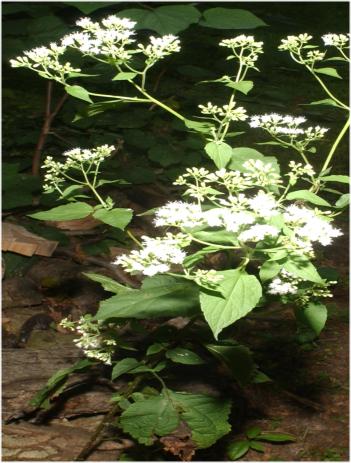| 09-11-03
Although Midwestern states, including Indiana, are best known for waves
of goldenrod when the sun starts its southward trek, damp, shaded spots
are now ablaze in white . . . meet white snakeroot (Eupatorium rugosum).
 This
member of the flat-topped cluster set of which there are many, occurs from
the lower parts of the middle and eastern Canadian provinces southward.
In Hoosierland it holds full sway at this time of year, especially at the
edges of thickets and damp woodlands where the earth holds good moisture
in the fall. This
member of the flat-topped cluster set of which there are many, occurs from
the lower parts of the middle and eastern Canadian provinces southward.
In Hoosierland it holds full sway at this time of year, especially at the
edges of thickets and damp woodlands where the earth holds good moisture
in the fall.
If you are wondering about the nomenclature of white snakeroot, washing
the earth away from the root system of the plant will give you some clues
. . . The roots are made up of a ball of many snake-like, cream-colored
fibers several inches long. Size and age of the plant seems to determined
length and diameter of the twine-like roots, which unlike the roots of
other plants, are not branched, but snake-like. The root system of a large,
mature plant usually is no larger than a tennis ball.
 |
This is the root system of white snakeroot. |
|

